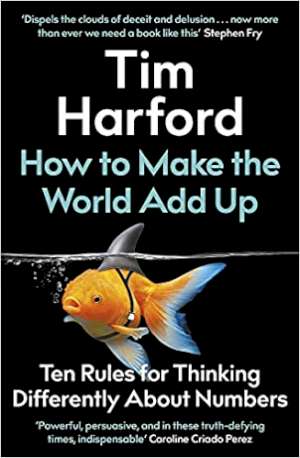26 November 2020
How to Make the World Add Up
Ten Rules for Thinking Differently About Numbers
Tim Harford
2020, The Bridge Street Press, 338 pages,
ISBN 9781408712245
Reviewer: Mario Pisani, HM Treasury

This is a book about statistics, and how to understand them better. It is perhaps a subject with which many Society of Professional Economists members will feel they are pretty familiar. After all, most of us economists have trained in statistical and quantitative methods. But in a way, that is precisely what makes this book so entertaining and compelling: a realisation that familiarity and understanding of the subject does not make one immune to erroneous logic or partial analysis. That – and the author’s immense skill in telling compelling stories about what would normally be a rather dry subject (the use of statistics).
Tim Harford is a senior columnist at the Financial Times, and a well-known author of popular economics books. His earlier work included the best-selling titles The Undercover Economist and The Undercover Economist Strikes Back, as well as more thematic books such as Adapt and Messy. Over the past decade or so he has also presented the Radio 4 programme More or Less, which aims to scrutinise and challenge, in a fun way, statistics used in public discourse. More recently he has also presented a podcast, Cautionary Tales, about the limits of rational decision-making among economic agents. In 2019 he was made an OBE for services to improving economic understanding.
How to Make the World Add Up starts with one of many outrageous propositions – that storks do indeed deliver babies. Statistics are produced which demonstrate this. Harford is quick to demolish this particular statistical straw man. Like a magician revealing the sleight of hand, he then explains exactly how he made the proposition seem plausible (in this case correlation due to a third factor like population size, and nothing to do with causation). This sets up one of the many devices used throughout the book. Using examples from history, popular culture, economic theory and social science research, Harford finds engaging ways to explain the many pitfalls that one may encounter when using statistics to understand the world.
The books in organised around chapters setting out ten different “lessons”, which Harford uses to give the reader “the confidence to pick up the telescope of statistics and use it to scrutinise the world”. For example, rule number one is “search your feelings”. To illustrate the potential impact of allowing emotions, preconceptions and unconscious biases to cloud one’s judgement, Harford tells the story of the Dutch art critic Abraham Bredius, who in the 1930s was one of the world’s foremost experts on Vermeer paintings. Then follows a wonderful enthralling story involving some previously undiscovered works by the Dutch old master, and a potent illustration of how considerable expertise can be of little use if emotions determine the response to new information.
Another rule is “step back and enjoy the view”, which encourages us to consider the wider context to give perspective on any given statistical claim. This is illustrated with an example of how, a few years ago, the press reported the claim that the murder rate in London that surpassed that in New York City. In his characteristic style, Harford blends examples from everyday life such as these with research insights from across the social sciences. In this example, we learn about the link between how frequently a claim is repeated and what people consider newsworthy.
Other chapters / lessons explore the role of data visualisations (illustrated by the story of Florence Nightingale’s effort in advocating better sanitation), the importance of ensuring statistics are produced by independent institutions free from political pressure, and the shortcomings of big data. One of my personal favourites in the lesson to “keep an open mind”, told via the tale of two great economists – John Maynard Keynes and Irving Fisher – and their approach to their own financial investment portfolios.
Overall, this is a thoroughly entertaining book that is also informative and insightful.
